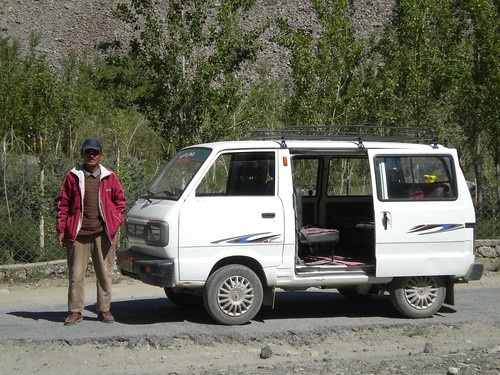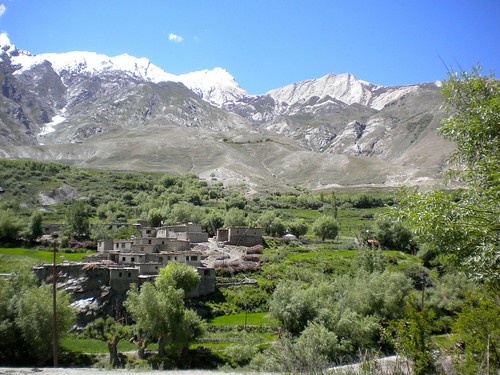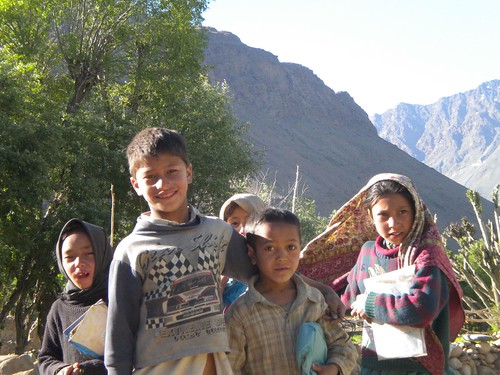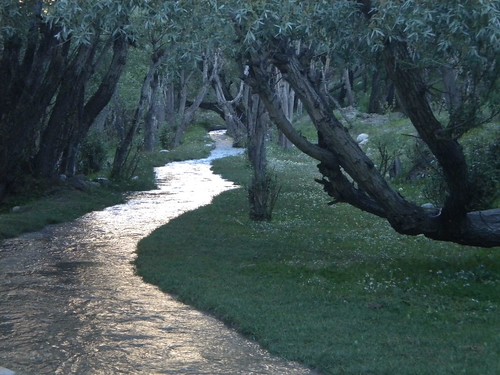We started off on our sojourn to Suru and Zanskar valleys with a ride from Kargil to Panikhar in  Mr. Mohd Hussein’s Maruti Omni. Even though we had vowed never to hire an Omni in Ladakh (after the scary Sonamarg-Kargil ride), we settled on one again as it was the only available car with a reasonable price tag! Moreover we were assured that though the road conditions in general are bad, the one to Suru valley is nowhere as treacherous as Zojila Pass; we decided to risk it and hopped on!
Mr. Mohd Hussein’s Maruti Omni. Even though we had vowed never to hire an Omni in Ladakh (after the scary Sonamarg-Kargil ride), we settled on one again as it was the only available car with a reasonable price tag! Moreover we were assured that though the road conditions in general are bad, the one to Suru valley is nowhere as treacherous as Zojila Pass; we decided to risk it and hopped on!
Suru valley is a fertile stretch of land on the banks of the Suru river, which is a tributary of the mighty Indus. The main road south from Kargil runs parallel to the river’s right bank. Initially, the ride wasn’t all that bumpy and the going was smooth. We passed many  tiny villages with fields stretching from the banks of the river to the base of the nearby mountains. The villages here are predominantly Muslim so the area is dotted with small but pretty mosques with brick minarets. The biggest village in Suru valley is Sanku, which turned out to be almost as big as a small town. We passed its buzzing market area and were told that most visitors halt here for a night stay as it has more stay options than the rest of the valley. However, once we passed Sanku and got deeper into the valley, everything quietened down. The villages became smaller and more spread out. And to our dismay, the roads deteriorated considerably! Sitting at the back of the mini-van, for the second time in 2 days, Madhu and I vowed never to ride in a Maruti Omni again¦
tiny villages with fields stretching from the banks of the river to the base of the nearby mountains. The villages here are predominantly Muslim so the area is dotted with small but pretty mosques with brick minarets. The biggest village in Suru valley is Sanku, which turned out to be almost as big as a small town. We passed its buzzing market area and were told that most visitors halt here for a night stay as it has more stay options than the rest of the valley. However, once we passed Sanku and got deeper into the valley, everything quietened down. The villages became smaller and more spread out. And to our dismay, the roads deteriorated considerably! Sitting at the back of the mini-van, for the second time in 2 days, Madhu and I vowed never to ride in a Maruti Omni again¦
Past Sanku, some 3kms east off the main road, is a small village called Karstekhar.  Buried deep in its fields is a large rocky outcrop on the face of which has been carved a 7m high image of Maitreya Buddha. We would have never found it on our own but Mohd Hussein knew exactly where it was and led us to it through a narrow, shaded trail that bordered one of the fields. Standing at the base of the Chamba, the image looked huge and unassailable; made us wonder, how centuries ago, monks could have carved something like this?!
Buried deep in its fields is a large rocky outcrop on the face of which has been carved a 7m high image of Maitreya Buddha. We would have never found it on our own but Mohd Hussein knew exactly where it was and led us to it through a narrow, shaded trail that bordered one of the fields. Standing at the base of the Chamba, the image looked huge and unassailable; made us wonder, how centuries ago, monks could have carved something like this?!
From here on, as we left the populated villages behind, the scenery got prettier and prettier with the feeling that we were getting within touching distance of the snow-capped mountains. We stopped several times along the way for photo-opportunities. Around 1pm we got to the picturesque little village of Panikhar, our first stop in Suru valley. It didn’t have many stay options: the govt-run tourist bungalow and a couple of guesthouses run by local families. We went to the tourist bungalow and were happy to find a room available for the night. We were even happier when told that the room rent was just Rs.200; we’ve never stayed in something this cheap before! The room was simple and quite basic but with an attached bathroom, which was more than we had expected. There were 2 single beds with a vanity mirror and table in the center. A solar-charged bulb provided light for the times when electricity was not available, which turned out to be for more than  20hrs daily. Hot water was provided in buckets by the friendly caretaker. Overall, a decent place for the price!
20hrs daily. Hot water was provided in buckets by the friendly caretaker. Overall, a decent place for the price!
Since there wasn’t enough time to prepare a proper meal for us, the caretaker prepared the all-time favorite backup meal: MAGGI! Then we took care of laundry and had a quick, refreshing nap before heading out to explore the lovely village. This was the first time that we were staying in a proper, non-touristy, rural village in J&K; it was all quite exciting!
As we walked south through the village, we passed small, traditional homes, tiny tea stalls  where elderly men sat outside for their daily gossip and lush green fields on which the younger men and women worked ceaselessly. School kids, free to play and roam the streets after a full day at school, eyed us curiously while some even followed us around for a while. It gave Madhu the perfect opportunity to click some candid pictures. They were all super-cute and super-giggly; we had a fun time with them!
where elderly men sat outside for their daily gossip and lush green fields on which the younger men and women worked ceaselessly. School kids, free to play and roam the streets after a full day at school, eyed us curiously while some even followed us around for a while. It gave Madhu the perfect opportunity to click some candid pictures. They were all super-cute and super-giggly; we had a fun time with them!
After a few minutes, when we reached the outer fringes of the village, we turned around to get back to the guesthouse. But on the way we met a friendly local who suggested that we walk north, across the Suru River, around the outer edges of the village and follow a circuitous route that would eventually lead us  back over the river and into the village again. Since we had still over an hour before sunset we took off on the suggested route. And I’m so glad we did! It was a lovely walk past more Ladakhi homes and over a rust-colored bridge spanning the fast-flowing Suru River. Beyond the bridge, we passed the forest dept’s freshly painted guesthouse. When we had enquired earlier, the caretaker there had said that he was expecting a visit from the officials today and was therefore unable to provide us with a room. Too bad; it looked nicer than the tourist bungalow! Later, when the road hit a T-junction, with the right fork leading to Kargil, we took a left and walked along a dusty path with a beautiful stream flowing by.
back over the river and into the village again. Since we had still over an hour before sunset we took off on the suggested route. And I’m so glad we did! It was a lovely walk past more Ladakhi homes and over a rust-colored bridge spanning the fast-flowing Suru River. Beyond the bridge, we passed the forest dept’s freshly painted guesthouse. When we had enquired earlier, the caretaker there had said that he was expecting a visit from the officials today and was therefore unable to provide us with a room. Too bad; it looked nicer than the tourist bungalow! Later, when the road hit a T-junction, with the right fork leading to Kargil, we took a left and walked along a dusty path with a beautiful stream flowing by.  The street was deserted except for a lone person who passed us in his tractor. The road eventually turned to a smaller, narrower bridge crossing the Suru River and then uphill back to Panikhar’s market area. It had been the nicest walk ever!
The street was deserted except for a lone person who passed us in his tractor. The road eventually turned to a smaller, narrower bridge crossing the Suru River and then uphill back to Panikhar’s market area. It had been the nicest walk ever!
In the market, we stopped to stock on some essentials (including some candy to bribe the local children with), chatted briefly with some locals who seemed genuinely friendly and warm, and then strolled back to the guesthouse around 7:30pm. There we met two youngsters from Rajasthan who had just checked in for the night. They turned out to be clothes salesmen who go about the villages, especially remote ones such as these, with large cloth bags full of dress materials and ready-made garments. Their families source the stuff from far-off Surat, which has a huge textile industry and then have them shipped to strategically-placed and well-connected towns like Srinagar and Kargil. From here the boys collect the ware and go about selling them in person going door-to-door. It was an intriguing business concept, one we hadn’t come across before! They had interesting stories of their travel around India. The funniest one was of when they strolled unknowingly across the Indian border on foot into the POK region, got slapped by the annoyed army personnel there and then sent back with a strict warning of never straying in that area again !
For dinner, the caretaker whipped up a simple yet tasty meal of plain rice and a watery sabzi (vegetable dish). It was probably the simplest meal we’d ever had in our lives and something told me that this is how it will be for the next few days as we venture deeper into the valley. During the meal, we chatted with the caretaker who told us a little about life in Panikhar. His house, where his family lived, was in the outskirts of the village across the river. His family spends the summer months cultivating the fields and generally preparing for winter. By October, the tourist bungalow is locked up and he returns to his family to spend the cold winter indoors. He said that the winters were too harsh to do anything other than tending to cattle and staying away from the wind and snow raging outside. His weather-beaten face spoke volumes of the hardships faced by these remote villages; it was our introduction to life in the cold mountains of India.


No comments yet.